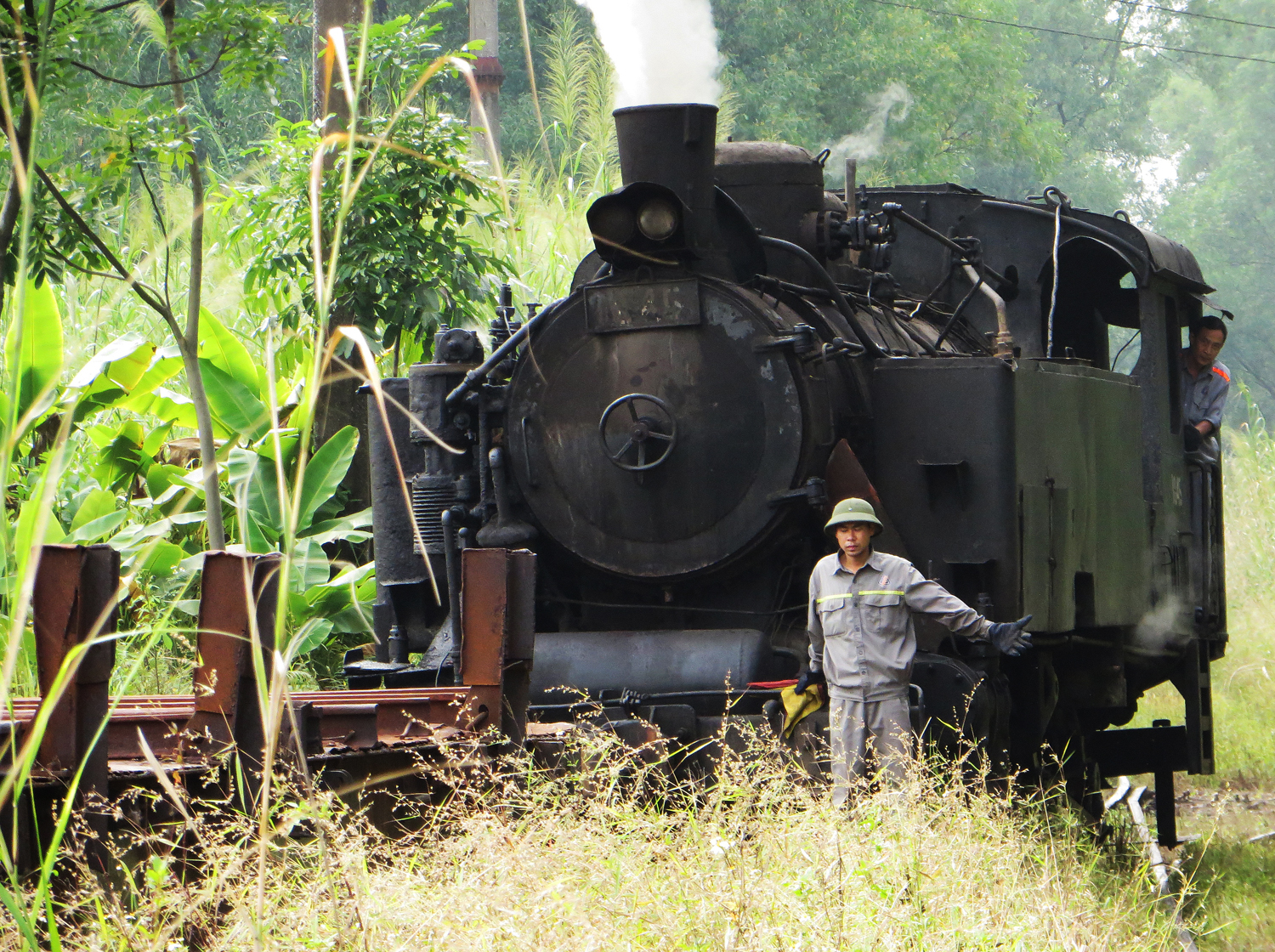
Gongjian 1.435m gauge 0-6-0T steam locomotive No 030-1045 arrives to collect passengers at the Thái Nguyên Iron and Steel Works event on 22 October 2014
This article was published previously in Saigoneer http://saigoneer.com
Wednesday 22 October 2014 was officially the last day of steam locomotive operations at Thái Nguyên Steel Works. Tim Doling takes a look at the history of this extraordinary industrial plant, which owes so much to the railway for its development.
The Thái Nguyên Iron and Steel Joint Stock Corporation (Công ty cổ phần Gang thép Thái Nguyên) was originally set up in 1959 by the Democratic Republic of Việt Nam as the Thái Nguyên Iron and Steel Company (Công ty Gang thép Thái Nguyên), with the aim of exploiting the region’s abundant iron resources. Construction of the plant got under way in the Spring of 1959 and it began operations in November 1963.
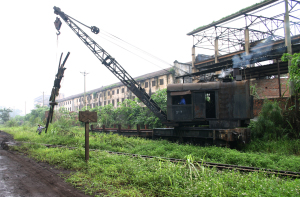
One of Thái Nguyên Iron and Steel Works’ steam cranes in action
From the outset, the railway played a crucially important role in the plant’s activities. Rail tracks were laid throughout the compound, and the Chinese government donated 11 Gongjian 1.435m gauge 0-6-0T steam locomotives (Nos. 030-1035 to 030-1045), four steam cranes, and a large fleet of flat, open-top and ore wagons.
Equal importance was given to the task of linking the steel works by rail with the main line, in order to ensure the direct passage of coal, iron ore and other raw materials into the factory and the shipping of the finished product to the Red River Delta.
In 1959-1960, a brand new railway line was built from Đông Anh (on the Hà Nội–Lào Cai line) to Thái Nguyên and Quán Triều. Then in late 1965, following the outbreak of war, the entire railway line from the Chinese border at Đồng Đăng to Yên Viên, Đông Anh, Thái Nguyên and Quán Triều was converted to dual gauge (both 1m and 1.435m), in order that supply trains could run directly from the standard-gauge (1.435m) Chinese network into Việt Nam.
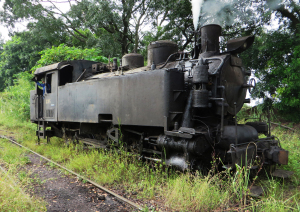
Another view of Gongjian 1.435m gauge 0-6-0T steam locomotive No 030-1045 on 22 October 2014
The operation of the steel works was deemed so important to the North Vietnamese war effort that in October 1965-December 1966, in response to repeated US bombing of the railway line from Yên Viên and Đông Anh, a second new strategic rail corridor to the steel works was built, this time of only 1.435m, linking Kép (on the Hà Nội–Đồng Đăng line) directly with Lưu Xá, south of Thái Nguyên.
After 1975, freight transportation to and from the Thái Nguyên Steel Works was gradually switched from rail to road. The standard-gauge Kép-Lưu Xá line was abandoned in the 1990s, and while the dual-gauge Hà Nội-Đông Anh-Thái Nguyên line remains operational, it now sees little traffic other than a daily market train.
However, the network of railway lines within the Thái Nguyên Steel Works has not only survived, but is still the primary means of moving ore, steel and other materials around the factory compound.
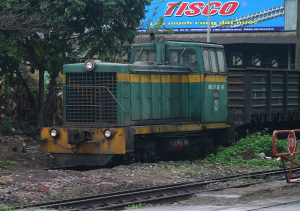
One of the factory’s second-hand Russian TU7E diesel hydraulic locomotives purchased from Vietnam Railways in the 1990s
In the 1990s, a fleet of second-hand Russian TU7E diesel hydraulic locomotives was purchased from Vietnam Railways, and in recent years, these have gradually replaced the original steam locomotives as the works’ main source of traction. Recently, a fleet of higher-powered diesels has been acquired to replace the ageing TU7Es.
Four of the works’ original Gongjian steam locomotives have survived, and on 22 October, one of their number – 030-1045 – made its last scheduled working appearance inside the compound. The locomotive participated in some light shunting activities and then toured the compound with its passengers (including a large group of Australian rail enthusiasts visiting Việt Nam with Scott McGregor’s Railway Adventures) perched behind it on a flat wagon – something which would definitely not be possible in the health-and-safety-obsessed west!
Happily, since No 030-1045 has recently been purchased by a private individual, the old steam engine’s appearance at Thái Nguyên Iron and Steel Works on 22 October 2014 will not be its last public outing. The new owner has plans to run future steam-hauled events in the north for rail enthusiasts. All enquiries regarding future steamings of locomotive 030-1045 should be directed to Mr Lưu at hanoirailtours@yahoo.com.

Iron ore being smelted with coke and limestone in a blast furnace, producing molten iron

Australian rail enthusiasts travelling on a flat truck behind Gongjian 1.435m gauge 0-6-0T steam locomotive No 030-1045 on 22 October 2014

Gongjian 1.435m gauge 0-6-0T steam locomotive No 030-1045 conveys its passengers across a public road outside the compound on 22 October 2014

Another view of Gongjian 1.435m gauge 0-6-0T steam locomotive No 030-1045 on 22 October 2014

A diagram of the complex rail track layout at Thái Nguyên Iron and Steel Works
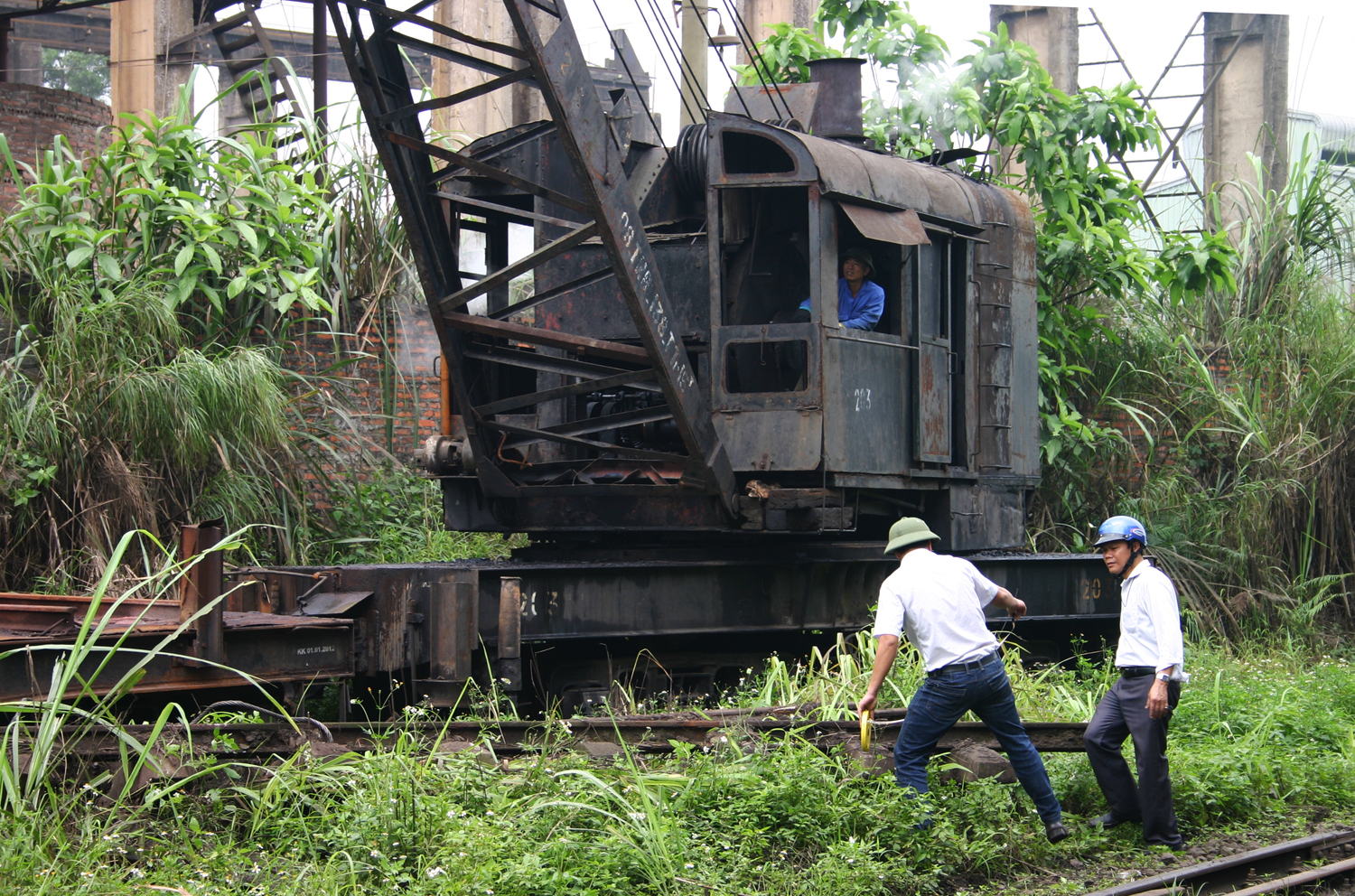
Another view of one of Thái Nguyên Iron and Steel Works’ steam cranes in action

Russian TU7E diesel hydraulic locomotives outside the factory’s engine shed

Three of the surviving four Gongjian 1.435m gauge 0-6-0T steam locomotives await their fate in the factory’s engine shed.
Tim Doling is the author of The Railways and Tramways of Việt Nam (White Lotus Press, Bangkok, 2012) and also gives talks on Việt Nam railway history to visiting groups.
A full index of all Tim’s blog articles since November 2013 is now available here.
Join the Facebook group Rail Thing – Railways and Tramways of Việt Nam for more information about Việt Nam’s railway and tramway history and all the latest news from Vietnam Railways.
You may also be interested in these articles on the railways and tramways of Việt Nam, Cambodia and Laos:
A Relic of the Steam Railway Age in Da Nang
By Tram to Hoi An
Date with the Wrecking Ball – Vietnam Railways Building
Derailing Saigon’s 1966 Monorail Dream
Dong Nai Forestry Tramway
Full Steam Ahead on Cambodia’s Toll Royal Railway
Ha Noi Tramway Network
How Vietnam’s Railways Looked in 1927
Indochina Railways in 1928
“It Seems that One Network is being Stripped to Re-equip Another” – The Controversial CFI Locomotive Exchange of 1935-1936
Phu Ninh Giang-Cam Giang Tramway
Saigon Tramway Network
Saigon’s Rubber Line
The Changing Faces of Sai Gon Railway Station, 1885-1983
The Langbian Cog Railway
The Long Bien Bridge – “A Misshapen but Essential Component of Ha Noi’s Heritage”
The Lost Railway Works of Truong Thi
The Mysterious Khon Island Portage Railway
The Railway which Became an Aerial Tramway
The Saigon-My Tho Railway Line

